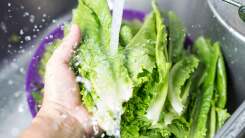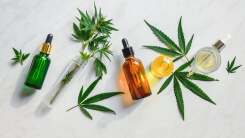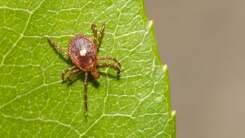Why Washing Lettuce Doesn’t Get Rid of E. Coli

Leafy greens have been the carriers for dozens of outbreaks of food poisoning in recent years. The CDC recently linked several to a particular strain of E. coli, but other outbreaks have involved Salmonella, norovirus, Listeria, and Cyclospora. If this unfun fact has you swearing you’ll wash your lettuce better, I have bad news: It’s not going to help much.
Shouldn’t we be washing produce anyway?
Yes, you should wash produce, according to the CDC. They recommend rinsing fruits and vegetables under running water, even fruits that you plan to peel.
To do a more thorough job, you can scrub waxy veggies with a brush. But forget about the more involved processes you may have heard about (or seen influencers do online). Washing with salt, vinegar, baking soda, or a combination is not any better than a thorough rinsing right before eating or cooking. (And while we’re busting myths: combining baking soda and vinegar provides some fizzing action, but ultimately neutralizes both chemicals, so there’s no need to combine them.)
Washing doesn’t remove germs from produce
Unfortunately, washing isn’t enough to guarantee contaminated food is safe to eat, although it can reduce the number of germs. Even when you soak veggies in bleach, the biofilms of bacteria living on a vegetable are hard to kill.
Although the CDC recommends washing, they emphasize that cooking is the only way to actually kill bacteria that might hitch a ride on your veggies. This means that there will always be a risk to eating salads or other dishes that contain fresh lettuce or other raw veggies.
When you do wash your lettuce, the CDC says to use plain water, not vinegar or commercial produce washes. Rinse the leaves under running water; soaking in a sink can transfer germs from one leaf to another, or from the sink to your food. Creating a germ soup is not going to help you keep food clean.
Keeping veggies in the fridge also reduces bacterial growth, since bacteria don’t grow well in the cold. Lettuce, salads, and cut fruits and vegetables should be kept at refrigerator temperature—at the store as well as at home. (Check your fridge temperature, by the way. It should be between 32 and 40 degrees Fahrenheit, and the colder it is, the longer your food will keep.)
Can you wash off pesticides?
Besides germs, you may be concerned about pesticide residues. Scientists at the Connecticut Agricultural Experiment Station washed produce with running water, and found that it reduced the amount of pesticide residue for 9 of the 12 tested pesticides. What’s especially interesting is that some of those removed pesticides weren’t water-soluble—so the pesticides weren’t being dissolved in water, but rather, mechanically pushed off the produce by the force of running water.
The same researchers expanded on their study a few years later, testing four commercial produce washes, including Fit, against a soap solution (1% Palmolive) and plain running water, treating lettuce, strawberries, or tomatoes with a solution and then running under water for a full minute. They couldn’t detect any differences between how well the different treatments cleaned, but all of the washed produce—including that washed with just water—ended up with less pesticide than the unwashed controls.
Even though soap performed as well as the other washes in these studies, and it makes sense that it would be able to remove oils and other contaminants, nobody is recommending you use soap. It doesn’t have any advantage over water, and you really don’t want to end up with soap residue on your food. The CDC specifically advises against using soap when washing produce.
The authors’ recommendation: Rinse produce under running water for at least 30 seconds. Cleaning products or soap aren’t necessary.
There’s one other thing you have to know about pesticides on produce: even unwashed, they’re not likely to be present at dangerous levels. The same study tested the amount of pesticides found on the produce bought at stores, and concluded that they were “generally well within tolerances set by the [Environmental Protection Agency].” In other words, you can wash at least some of the pesticide off your produce, but the amount originally on your produce was probably not a problem to begin with.
We saw this before when discussing the Dirty Dozen—even the “dirtiest” produce didn’t have unsafe levels of pesticides, and buying organic doesn’t bypass the issue: Organic farming still uses pesticides, just different types.
One other caveat: Some pesticides are either incorporated into the plant’s tissues as it grows, or are simply hard to remove. These pesticides have undergone extensive testing and aren’t a serious health hazard. So, while you can’t rely on removing 100% of pesticides, your produce probably starts with harmless amounts and washing will reduce the amount further.



